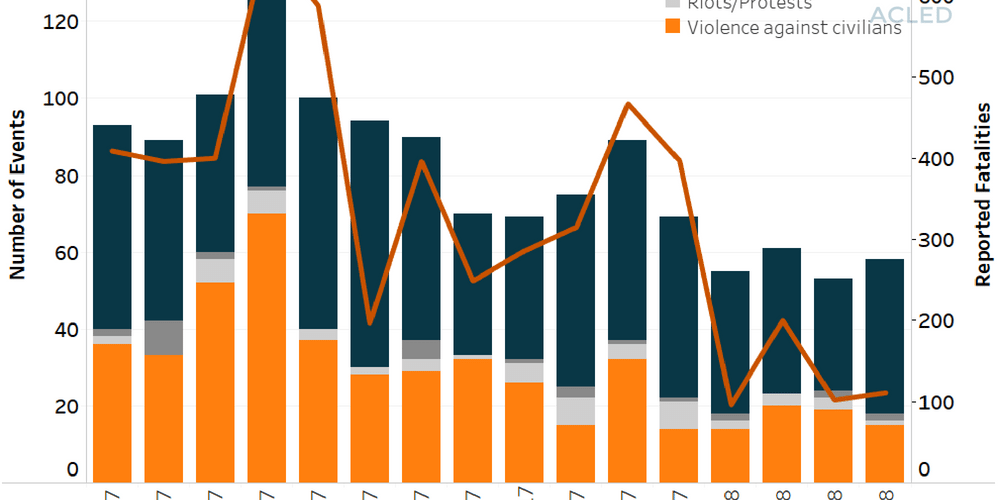Following the signing of the Cessation of Hostilities Agreement on 21 December 2017, conflict activity in South Sudan has reduced. This period in South Sudan corresponds the dry season, when the conflict is usually expected to resume (ACLED, November 2017), however, the totals of monthly fatalities since the agreement have remained significantly lower than in the same period last year (see Figure 1).
The relative calm can be attributed to the signing of the agreement by 12 of the parties engaged in the South Sudan conflict. The agreement is not stable – it was broken only hours after coming into effect, and there are continued clashes throughout the country (UN, 24 January 2018). However, groups engaged in clashes now need to justify their actions with regard to the ceasefire deal, so the threshold for opening fire is higher. Any groups that do engage in conflict try to frame the attacks as criminal violence (see e.g. Radio Tamazuj, 19 April 2018).
However, in the last two weeks of April, battles between the government forces and Sudan People’s Liberation Army-In Opposition (SPLA-IO) have intensified in Unity, Jonglei and Central Equatoria provinces. The increased activity appears to be driven by anxieties about accessing leverage in the peace talks, scheduled to start on 17 May, as well as jostling for position before President Salva Kiir’s term ends in July. This jostling is also reflected in the party activity.
On 3-5 May, the ruling party held a meeting to attempt to reunify the disputing factions of the SPLM, but it was unsuccessful, as the SPLA-IO leader Riek Machar and several members of the Sudanese Peoples Liberation Movement-Former Detainees (SPLM-FD) did not accept the invitation (Eye Radio, 4 May 2018).
On 9 April, exiled former army chief, Paul Malong, announced the launch of his new opposition movement South Sudan-United Front (SS-UF) (Gurtong, 10 April 2018). This is believed to be a political group intending to participate in the 17 May peace talks, rather than a military development, but the SPLA-IO is already encouraging Malong to take up arms (IRIN, 12 April 2018).
Finally, the opposition movements are pushing for a coalition. On 1 March, nine of them formed the South Sudan Opposition Alliance (SSOA), a coalition that seeks to work together at the next round of peace talks. The new coalition includes Federal Democratic Party (FDP), New Salvation Front (NAS), National Democratic Movement (NDM), South Sudan Liberation Movement (SSLM), South Sudan Patriotic Movement (SSPM), South Sudan United Liberation Movement (SSULM) and United Democratic Republic Alliance (UDRA) (Sudan Tribune, 1 March). This coalition is an attempt to combine opposition forces against the ruling party in the peace talks. However, the group remains fractured.
Originally, also the SPLA-IO considered joining the SSOA, but pulled out after a disagreement over the alliance’s leadership (Radio Tamazuj, 4 March). Since the cessation, the SPLA-IO has clashed occasionally with other opposition groups, particularly with the NAS and the Taban Deng Gai faction of the SPLA-IO. Moreover, recent defections of significant numbers of SPLA-IO combatants to NAS in Central Equatoria (Radio Tamazuj, 16 January and 13 April) and the formal fusion of the Taban Deng Gai’s faction to the ruling party (Sudan Tribune, 8 May) indicate that front lines and power balances between the groups are shifting again. This will affect the stability of the coalition ahead of the 17 May peace talks.
AfricaAnalysisCivilians At RiskConflict MonitoringFocus On MilitiasPeacekeepingPolitical StabilityPro-Government MilitiasViolence Against Civilians






